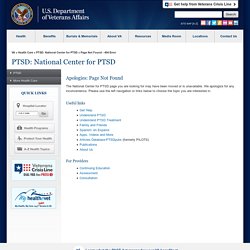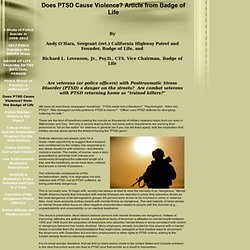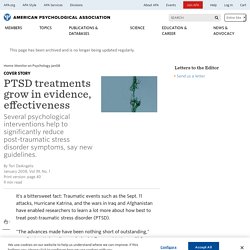

The Creation, Expansion, and Embodiment of Posttraumatic Stress Disorder. A Case Study in Historical Critical Psychopathology Authors: Scott A.

Post-Traumatic Stress Disorder (PTSD) - Psychology. The Politics of PTSD. By Mary Sykes Wylie In retrospect, it seems bizarre that hundreds of thousands of veterans, all suffering from similar, dramatic symptoms, could be largely ignored by the Veterans Administration (VA) and psychiatry in general.

But before the 1970s, almost no mental health authorities--military or civilian--imagined, much less expected and prepared for, traumatic reactions to war to emerge years after the conflict ended. There was yet no official traumatic stress diagnosis, and the VA assumed that any psychiatric problem occurring more than one year after discharge couldn't be related to military service. During the Korean War, for the first time, clinicians provided frontline treatment for psychiatric breakdowns, returning the soldiers to battle as soon as possible afterward.
And the Vietnamese didn't appreciate being "saved" and "liberated"; it was often impossible to tell friend from foe. The diagnosis was as much a political victory as a shift in the terrain of mental health. PTSD_Case_Study.pdf. PTSD History and Overview. Matthew J.

Friedman, MD, PhD A brief history of the PTSD diagnosis The risk of exposure to trauma has been a part of the human condition since we evolved as a species. Attacks by saber tooth tigers or twenty-first century terrorists have probably produced similar psychological sequelae in the survivors of such violence. Shakespeare's Henry IV appears to meet many, if not all, of the diagnostic criteria for Posttraumatic Stress Disorder (PTSD), as have other heroes and heroines throughout the world's literature.
In 1980, the American Psychiatric Association (APA) added PTSD to the third edition of its Diagnostic and Statistical Manual of Mental Disorders (DSM-III) nosologic classification scheme (2). Importance of traumatic events In its initial DSM-III formulation, a traumatic event was conceptualized as a catastrophic stressor that was outside the range of usual human experience. Revisions to PTSD diagnostic criteria DSM-5 Criteria for PTSD diagnosis. PTSD and ADHD – Are We Misdiagnosing? I recently came across a study in the journal Child Abuse & Neglect that disturbed me.

Victor Carrion, MD led a team of Stanford University researchers who looked at children living in a poor, violent neighborhood. This study built on past findings which associated worsening adult health to their childhood exposure to nine types of adverse childhood events. The investigators most recently found a strong link between adverse childhood experiences such as abuse, trauma and neglect, and the children’s mental and physical health. Reviewing the medical charts of 701 pediatric patients from the Bayview Child Health Center in San Francisco, they found that 67% of the children had experienced 1 or more categories of adverse childhood experiences (ACEs).
Even worse, 12% had experienced 4 or more ACEs. Increased ACE scores correlated with increased risk of learning/behavior problems and obesity. I’m sure that for most of you, this research isn’t necessarily surprising. Please leave a comment below. Does PTSD Make You Dangerous? from the Badge of Life. Defense attorneys are always open for a ready-made opportunity to suggest that a suspect was conditioned by the military into responding to any stress situations with violence—and thereby commit a murder.

The media, of course, sees a story guaranteed to generate both interest and controversy throughout the extended length of a trial, and the headlines, as we have seen, inflame and arouse a variety of passions. The unfortunate consequence of this sensationalism, sadly, is to stigmatize not only veterans with PTSD, but all PTSD sufferers, as being potentially dangerous. This is not really new. To begin with, society has always tended to view the mentally ill as “dangerous.” Mental Health America reports that characters with mental illnesses are depicted in prime time television shows as the most dangerous of all demographic groups: 60 percent were shown to be involved in crime or violence. The result is predictable. Where do we begin, in order to address this question? · flashbacks. Post-traumatic stress disorder in occupational settings: anticipating and managing the risk. + Author Affiliations Correspondence to: Alexander C.

McFarlane, Centre of Military and Veterans Health, University of Adelaide, 122 Frome Street, Adelaide, South Australia 5000, Australia. Tel: +61 303 5200; fax: +61 303 5368; e-mail: alexander.mcfarlane@adelaide.edu.au Abstract Background Post-traumatic stress disorder has had a substantial impact on employer liability for workplace psychological injury. Methods This field is not well represented in standard keyword searches and Medline was examined with linked fields of practice and research.
Results Organizations need to anticipate the possible traumatic exposures that may affect the workforce and have strategies to deal with the effects in the workplace, particularly the negative mental health outcomes in some personnel. PTSD treatments grow in evidence, effectiveness. It's a bittersweet fact: Traumatic events such as the Sept. 11 attacks, Hurricane Katrina, and the wars in Iraq and Afghanistan have enabled researchers to learn a lot more about how best to treat post-traumatic stress disorder (PTSD).

"The advances made have been nothing short of outstanding," says Boston University psychologist Terence M.